Gridded Water Resource Distribution Simulation for China Based on Third-Order Basin Data from 2002
Abstract
:1. Introduction
2. Materials and Methods
2.1. Study Area and Data
2.2. Study Methods
2.2.1. Spatial Autocorrelation Test
2.2.2. Model and Variables
2.2.3. Accuracy Evaluation of Gridded Water Resources Distribution Simulation
3. Results
3.1. Result of the Spatial Autocorrelation Test
3.2. Model Selection, Parameter Estimation, and Statistic Test
3.3. Gridded Water Resources Distribution Simulation
3.4. Accuracy Assessment for the Gridded Water Resource Distribution
4. Discussion
5. Conclusions
Acknowledgments
Author Contributions
Conflicts of Interest
References
- Gao, X.; Yu, T.F. The temporal-spatial variation of water resources constraint on urbanization in the northwestern China: Examples from the Gansu section of west Longhai-lanxin economic zone. Environ. Earth Sci. 2014, 71, 4029–4037. [Google Scholar] [CrossRef]
- Bao, C.; He, D.M. The causal relationship between urbanization, economic growth and water use change in provincial China. Sustainability 2015, 7, 16076–16085. [Google Scholar] [CrossRef]
- Liu, C.M.; Yu, J.J.; Kendy, E. Groundwater exploitation and its impact on the environment in the north China plain. Water Int. 2001, 26, 265–272. [Google Scholar]
- Bao, C.; Fang, C.L. Water resources constraint force on urbanization in water deficient regions: A case study of the Hexi Corridor, arid area of NW China. Ecol. Econ. 2007, 62, 508–517. [Google Scholar] [CrossRef]
- Jiang, Y. China’s water scarcity. J. Environ. Manag. 2009, 90, 3185–3196. [Google Scholar] [CrossRef] [PubMed]
- Yu, X.M.; Geng, Y.; Heck, P.; Xue, B. A review of China’s rural water management. Sustainability 2015, 7, 5773–5792. [Google Scholar] [CrossRef]
- Young, R.A.; Bredehoeft, J.D. Digital-computer simulation for solving management problems of conjunctive groundwater and surface water systems. Water Resour. Res. 1972, 8, 533–556. [Google Scholar] [CrossRef]
- Uhlenbrook, S. Biofuel and water cycle dynamics: What are the related challenges for hydrological processes research? Hydrol. Process. 2007, 21, 3647–3650. [Google Scholar] [CrossRef]
- Carvallo, H.O.; Cassel, D.K.; Bauer, A. Water losses from an irrigated soybean field by deep percolation and evapotranspiration. Water Resour. Res. 1975, 11, 267. [Google Scholar] [CrossRef]
- Guo, Y.; Shen, Y.J. Quantifying water and energy budgets and the impacts of climatic and human factors in the Haihe River Basin, China: 2. Trends and implications to water resources. J. Hydrol. 2015, 527, 251–261. [Google Scholar] [CrossRef]
- Wasowski, J.; Lamanna, C.; Gigante, G.; Casarano, D. High resolution satellite imagery analysis for inferring surface-subsurface water relationships in unstable slopes. Remote Sens. Environ. 2012, 124, 135–148. [Google Scholar] [CrossRef]
- Mace, R.E. Comment on “long-term (1930–2010) trends in groundwater levels in texas: Influences of soils, landcover, and water use” by Sriroop Chauduri and Srinivasulu Ale. Sci. Total Environ. 2015, 517, 259–262. [Google Scholar] [CrossRef] [PubMed]
- Do, V.; Thomas-Agnan, C.; Vanhems, A. Accuracy of areal interpolation methods for count data. Spat. Stat. 2015, 14, 412–438. [Google Scholar] [CrossRef]
- Sager, G. Areal interpolation for tidal streams. Beitr. Meereskd. 1975, 36, 85–94. [Google Scholar]
- Wu, S.-S.; Qiu, X.; Wang, L. Population estimation methods in gis and remote sensing: A review. Gisci. Remote Sens. 2005, 42, 80–96. [Google Scholar] [CrossRef]
- Xie, Z. A framework for interpolating the population surface at the residential-housing-unit level. Gisci. Remote Sens. 2006, 43, 233–251. [Google Scholar] [CrossRef]
- Thorpe, W.R.; Rose, C.W.; Simpson, R.W. Areal interpolation of rainfall with a double fourier-series. J. Hydrol. 1979, 42, 171–177. [Google Scholar] [CrossRef]
- D’Antona, G.; Seifnaraghi, N. Temperature distribution reconstruction by eigenfunction interpolation of boundary measurement data. IEEE Trans. Instrum. Meas. 2014, 63, 334–342. [Google Scholar] [CrossRef]
- Silvan-Cardenas, J.L.; Wang, L.; Rogerson, P.; Wu, C.; Feng, T.; Kamphaus, B.D. Assessing fine-spatial-resolution remote sensing for small-area population estimation. Int. J. Remote Sens. 2010, 31, 5605–5634. [Google Scholar] [CrossRef]
- Lo, C.P. Population estimation using geographically weighted regression. Gisci. Remote Sens. 2008, 45, 131–148. [Google Scholar] [CrossRef]
- Montello, D.R.; Fabrikant, S.I.; Ruocco, M.; Middleton, R.S. Testing the first law of cognitive geography on point-display spatializations. In Spatial Information Theory. Foundations of Geographic Information Science; Lecture Notes in Computer Science; Springer: Berlin/Heidelberg, Germay, 2003; Volume 2825, pp. 316–331. [Google Scholar]
- Qu, X.; Lee, L.F. Estimating a spatial autoregressive model with an endogenous spatial weight matrix. J. Econom. 2015, 184, 209–232. [Google Scholar] [CrossRef]
- Shen, C.H.; Li, C.L.; Si, Y.L. Spatio-temporal autocorrelation measures for nonstationary series: A new temporally detrended spatio-temporal moran’s index. Phys. Lett. A 2016, 380, 106–116. [Google Scholar] [CrossRef]
- Ma, W.; Ji, J.P.; Chen, P.; Zhao, T.T. Spatial-temporal patterns analysis of property crime in urban district based on Moran’s I and GIS. Inf. Technol. Comput. Appl. Eng. 2014, 253–258. [Google Scholar]
- Epperson, B.K.; Li, T.Q. Measurement of genetic structure within populations using Moran’s spatial autocorrelation statistics. Proc. Natl. Acad. Sci. USA 1996, 93, 10528–10532. [Google Scholar] [CrossRef] [PubMed]
- Anselin, L. Local indicators of spatial association—LISA. Geogr. Anal. 1995, 27, 93–115. [Google Scholar] [CrossRef]
- Fu, W.J.; Jiang, P.K.; Zhou, G.M.; Zhao, K.L. Using Moran’s I and GIS to study the spatial pattern of forest litter carbon density in a subtropical region of southeastern China. Biogeosciences 2014, 11, 2401–2409. [Google Scholar] [CrossRef] [Green Version]
- Cressie, N.; Collins, L.B. Patterns in spatial point locations: Local indicators of spatial association in a minefield with clutter. Nav. Res. Log. 2001, 48, 333–347. [Google Scholar] [CrossRef]
- Zaman, G.; Goschin, Z. Economic downfall and speed of recovery in romanian counties. A spatial autoregressive model. Econ. Comput. Econ. Cybem. 2015, 49, 21–40. [Google Scholar]
- Nankervis, J.C.; Savin, N.E. Testing the autoregressive parameter with the t statistic. J. Econom. 1985, 27, 143–161. [Google Scholar] [CrossRef]
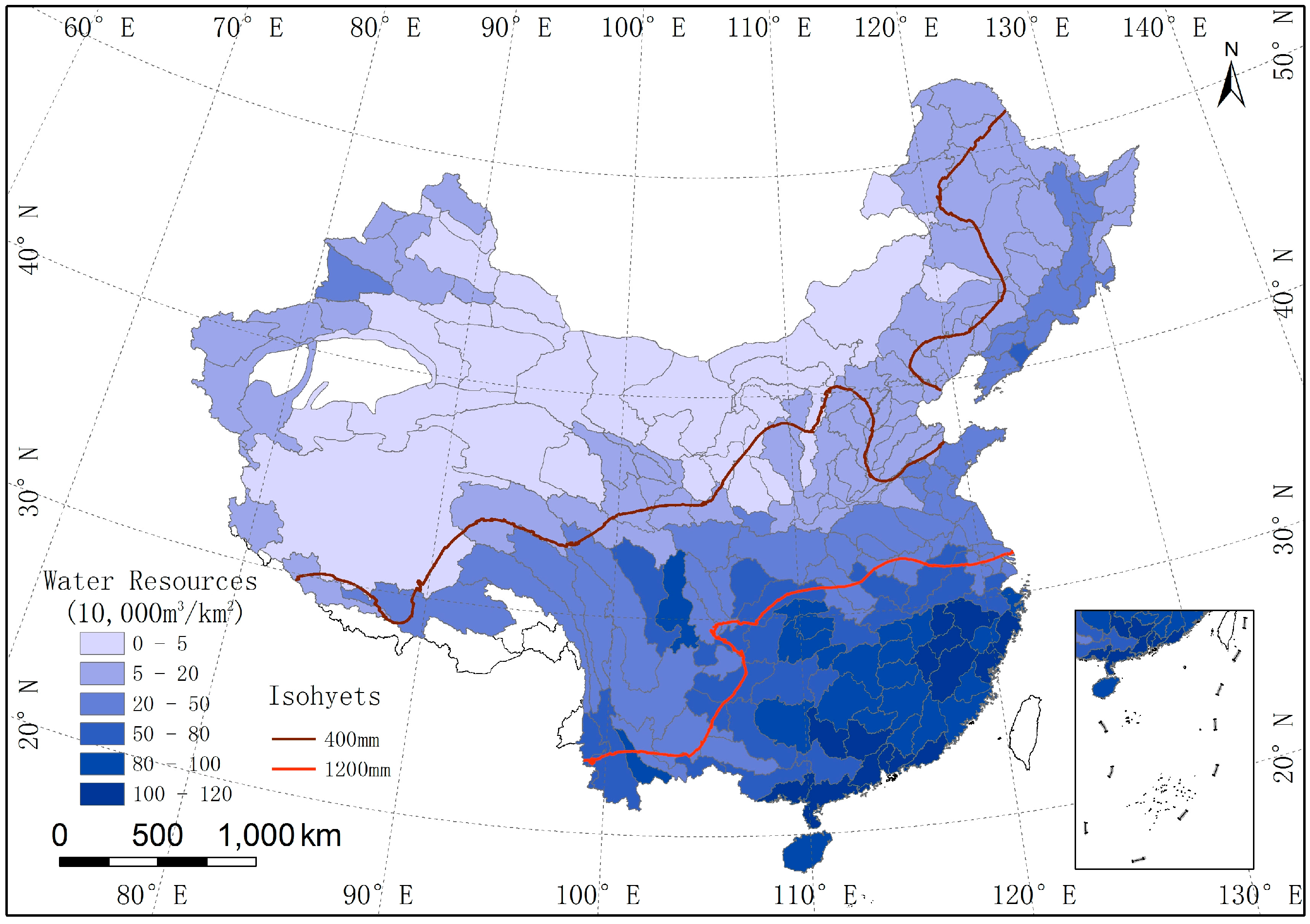
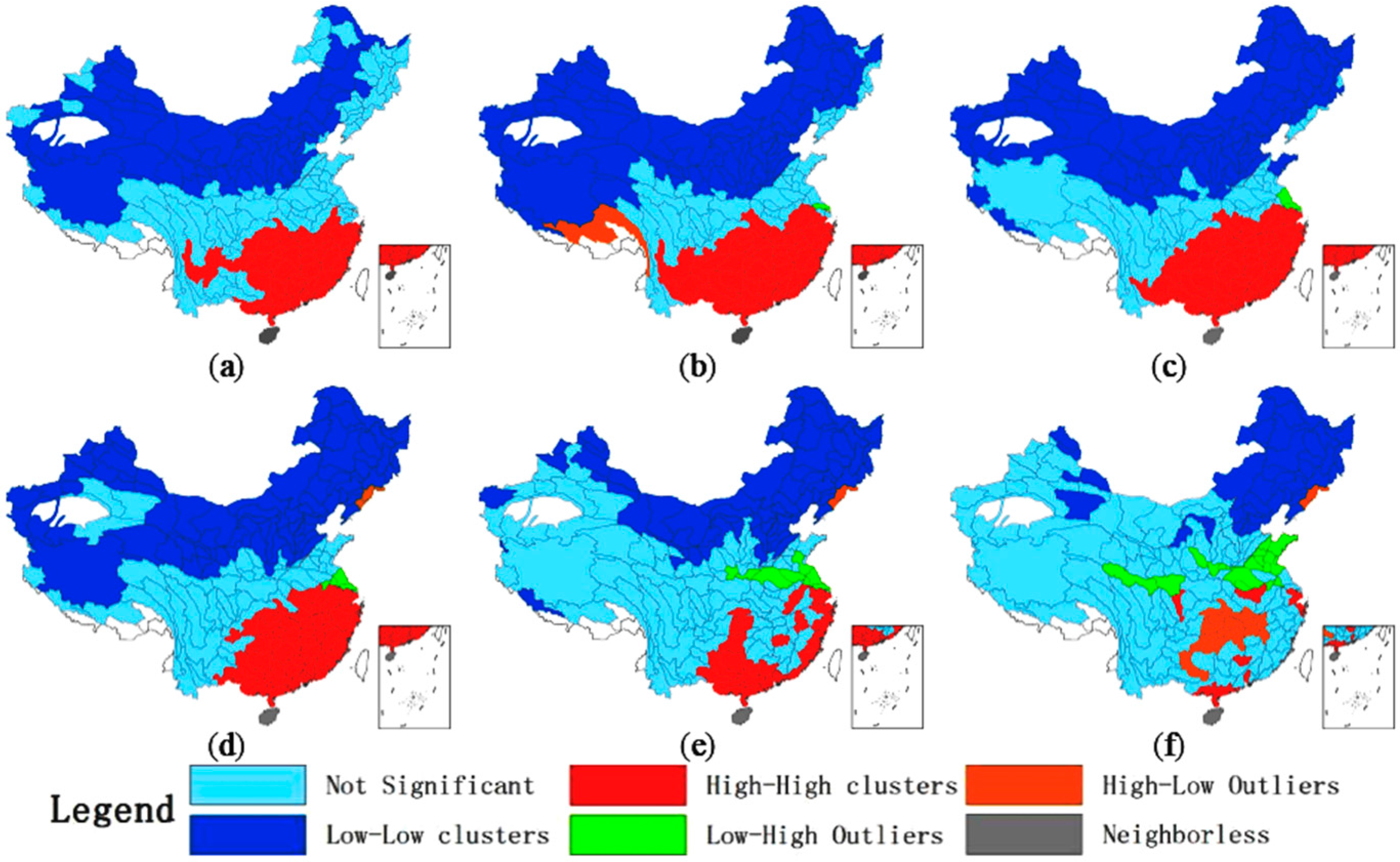

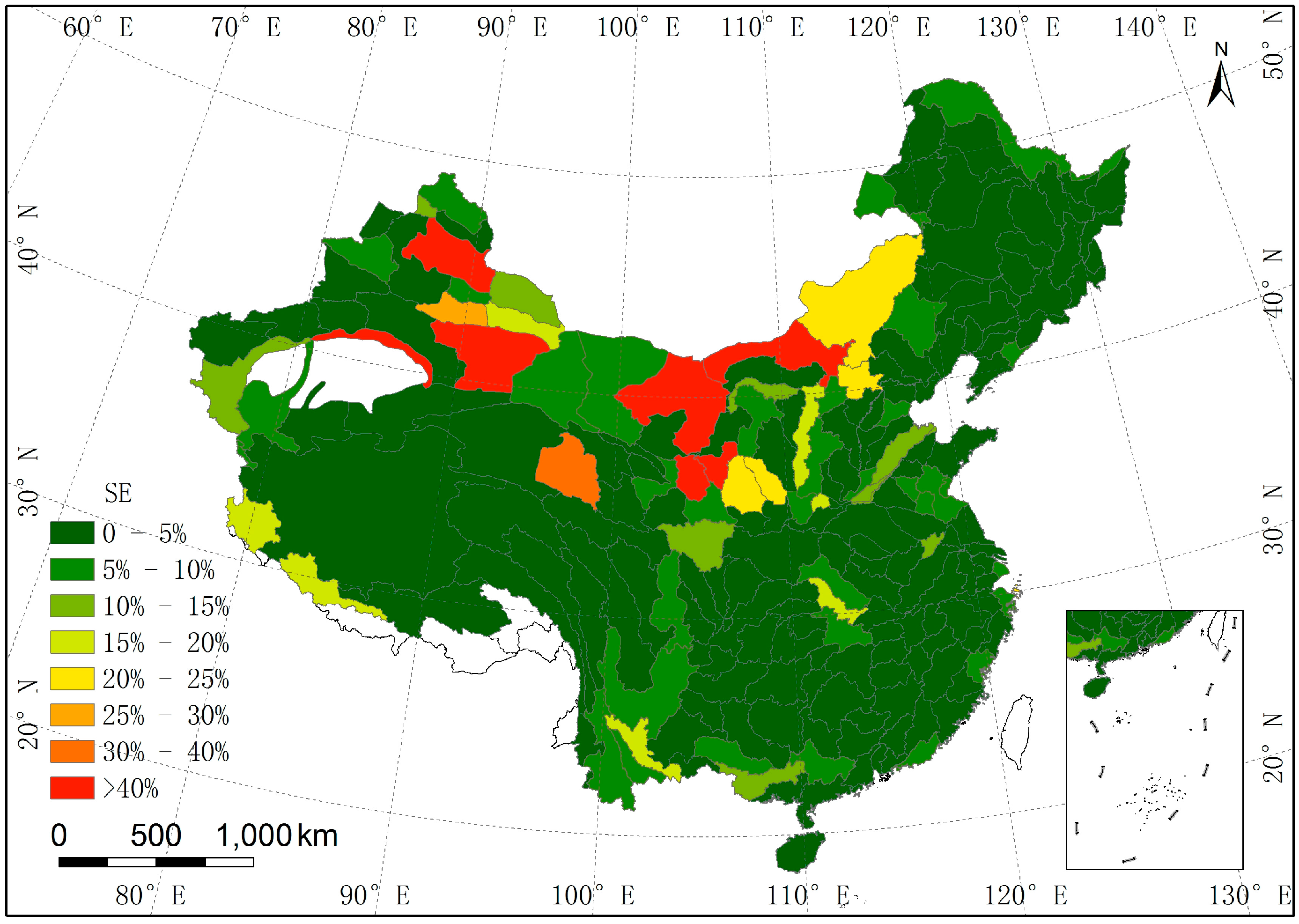
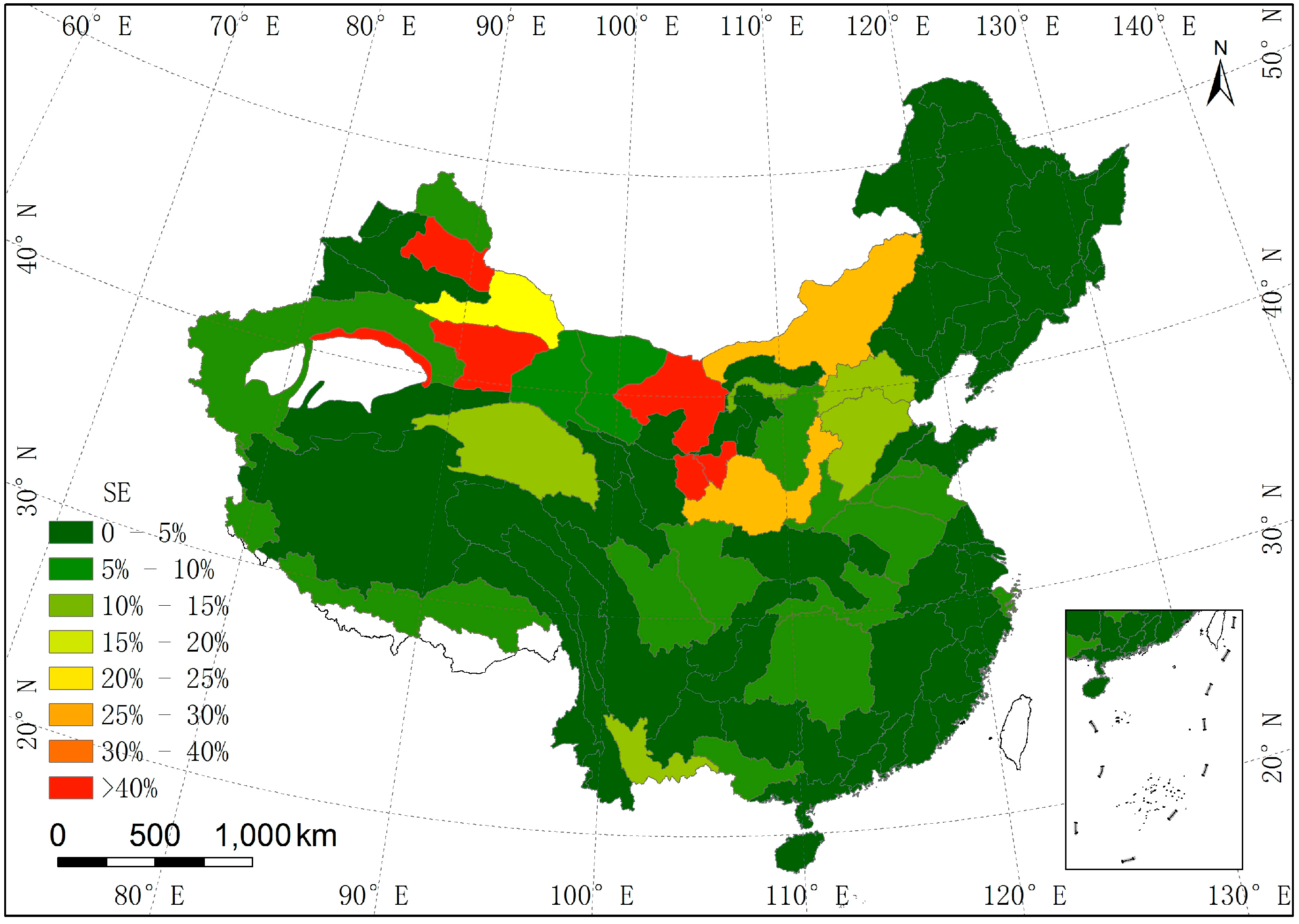

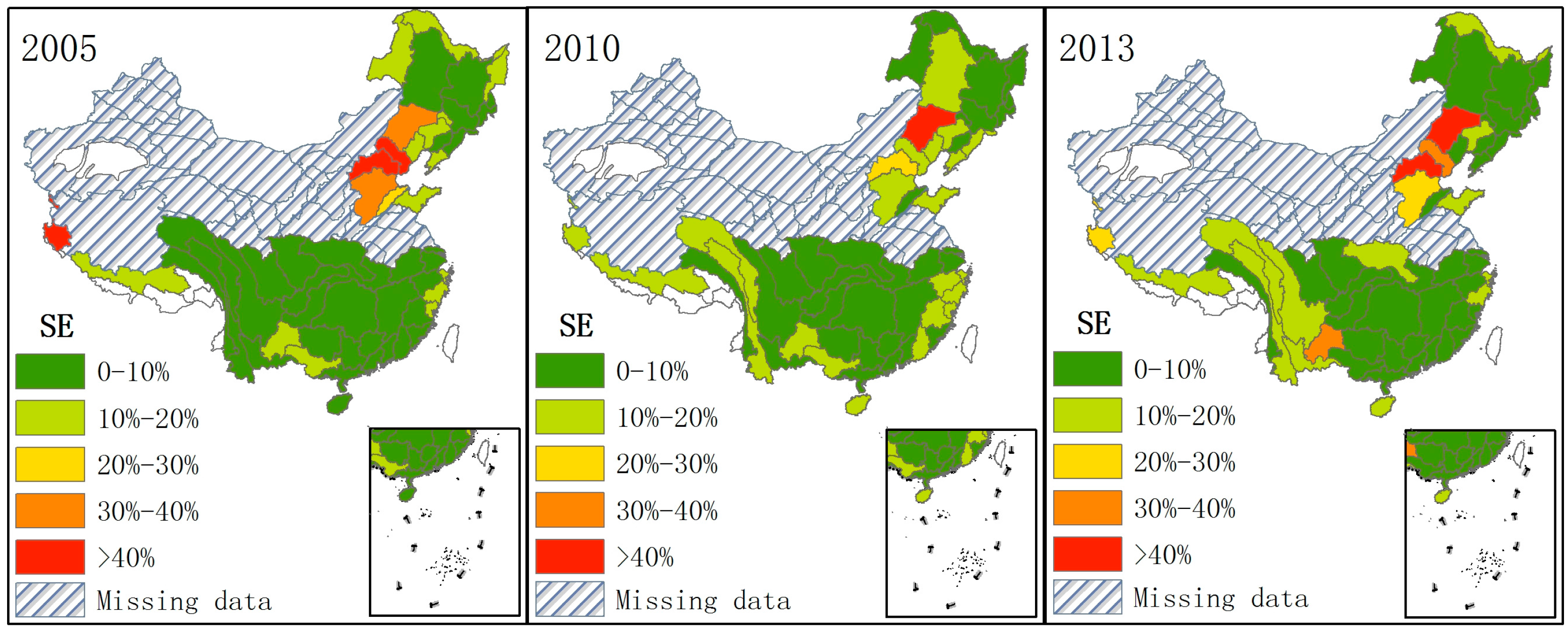

| Variable (Unit) | Mean | Maximum | Minimum | Standard Deviation |
|---|---|---|---|---|
| Water resources (10,000 m3) | 38.015 | 191.638 | 0.000 | 37.257 |
| Precipitation (mm) | 846.594 | 2181.760 | 48.2926 | 628.594 |
| Evapotranspiration (mm) | 19,843.25 | 76,282.100 | 4215.51 | 16,055.15 |
| Glacier (m2) | 42.260 | 1095.850 | 0.000 | 152.622 |
| Slope (%) | 2.267 | 12.252 | 0.000 | 2.053 |
| Forestland (m2) | 3030.345 | 8704.670 | 0.000 | 2628.708 |
| Temperature (°C) | 7.440 | 28.120 | –8.609 | 7.227 |
| Spatial Weight Type | Global Moran’s I | p-Value |
|---|---|---|
| First-order contiguity | 0.8800 | 0.001 |
| Second-order contiguity | 0.8082 | 0.001 |
| Third-order contiguity | 0.6879 | 0.001 |
| Fourth-order contiguity | 0.5332 | 0.001 |
| Fifth-order contiguity | 0.3325 | 0.001 |
| Sixth-order contiguity | 0.0764 | 0.001 |
| Statistic | Value | p-Value |
|---|---|---|
| LM lag | 28.7437 | 0.00000 |
| Robust LM lag | 0.2481 | 0.61841 |
| LM error | 74.2686 | 0.00000 |
| Robust LM error | 45.7730 | 0.00000 |
| Dependent Varibale: | Model (1) | Model (2) | Model (3) | Model (4) | Model (5) | Model (6) |
|---|---|---|---|---|---|---|
| (t) | –4.743 (–1.493) | –12.687 *** (–4.445) | –12.720 *** (–4.484) | –12.522 *** (–4.378) | –13.390 *** (–4.184) | –13.293 *** (–4.267) |
| (t) | 0.052 *** (18.738) | 0.052 *** (22.285) | 0.047 *** (12.590) | 0.047 *** (12.363) | 0.047 *** (12.219) | 0.046 *** (10.915) |
| (t) | 3.388 *** (7.617) | 3.491 *** (7.836) | 3.639 *** (7.631) | 3.665 *** (7.656) | 3.428 *** (6.338) | |
| (t) | 0.545 (1.748) | 0.552 (1.767) | 0.500 (1.554) | 0.522 (1.643) | ||
| (t) | –0.006 (–0.855) | –0.007 (–0.985) | –0.005 (–0.742) | |||
| (t) | 0.00003 (0.574) | 0.00004 (0.615) | ||||
| (t) | 0.0005 (0.899) | |||||
| (t) | 0.683 *** (11.338) | 0.662 *** (10.583) | 0.663 *** (10.405) | 0.666 *** (10.716) | 0.662 *** (10.583) | 0.648 *** (10.099) |
| R2 | 0.9280 | 0.9433 | 0.9441 | 0.9444 | 0.9444 | 0.9443 |
| LogL | –763.04 | –737.53 | –736.02 | –735.65 | –735.490 | –735.113 |
| AIC | 1530.07 | 1481.07 | 1480.03 | 1481.31 | 1482.98 | 1484.23 |
| SC | 1536.73 | 1491.05 | 1493.34 | 1497.95 | 1502.95 | 1507.52 |
| LR (p) | 76.6118 *** (0.000) | 71.0819 *** (0.000) | 72.3454 *** (0.000) | 73.0551 *** (0.000) | 71.8897 *** (0.000) | 62.2941 *** (0.000) |
| Variable | Precipitation | Slope | Temperature | Glacier | Evapotranspiration | Forestland |
|---|---|---|---|---|---|---|
| Precipitation | 1 | 0.014 | 0.839 | –0.275 | –0.141 | 0.719 |
| Slope | 0.014 | 1 | –0.050 | 0.389 | 0.140 | 0.202 |
| Temperature | 0.839 | –0.050 | 1 | –0.215 | –0.011 | 0.467 |
| Glacier | –0.275 | 0.389 | –0.215 | 1 | 0.495 | –0.267 |
| Evapotranspiration | –0.141 | 0.140 | –0.011 | 0.495 | 1 | –0.250 |
| Forestland | 0.719 | 0.202 | 0.467 | –0.267 | –0.250 | 1 |
| Dependent Variable: | Model (7) | Model (8) | Model (9) | Model (10) | Model (11) | Model (12) |
|---|---|---|---|---|---|---|
| (t) | –6.084 (–4.400) | –12.789 *** (–8.698) | –12.693 *** (–8.720) | –12.600 *** (–8.743) | –14.205 *** (–8.286) | –14.259 *** (–8.176) |
| (t) | 0.052 *** (39.137) | 0.052 *** (44.668) | 0.049 *** (29.118) | 0.044 *** (15.286) | 0.044 *** (15.429) | 0.044 *** (15.392) |
| (t) | 3.133 *** (8.007) | 2.877 *** (7.142) | 2.893 *** (7.253) | 2.739 *** (6.730) | 2.772 *** (6.197) | |
| (t) | 0.456 *** (2.282) | 0.408 *** (2.031) | 0.405 ** (2.010) | |||
| (t) | –0.001 (–0.181) | |||||
| (t) | 0.00008 (1.709) | 0.00009 (1.616) | ||||
| (t) | 0.0009 *** (2.304) | 0.0013 *** (2.968) | 0.0014 *** (3.278) | 0.0014 *** (3.202) | ||
| R2 | 0.8824 | 0.9107 | 0.9130 | 0.9444 | 0.9164 | 0.9164 |
| LogL | –801.34 | –773.075 | –770.40 | –767.77 | –766.28 | –766.26 |
| AIC | 1606.69 | 1552.15 | 1548.81 | 1545.54 | 1544.55 | 1546.52 |
| SC | 1613.34 | 1562.13 | 1562.12 | 1562.18 | 1546.52 | 1569.81 |
© 2016 by the authors; licensee MDPI, Basel, Switzerland. This article is an open access article distributed under the terms and conditions of the Creative Commons Attribution (CC-BY) license (http://creativecommons.org/licenses/by/4.0/).
Share and Cite
Tu, M.; Wang, F.; Zhou, Y.; Wang, S. Gridded Water Resource Distribution Simulation for China Based on Third-Order Basin Data from 2002. Sustainability 2016, 8, 1309. https://doi.org/10.3390/su8121309
Tu M, Wang F, Zhou Y, Wang S. Gridded Water Resource Distribution Simulation for China Based on Third-Order Basin Data from 2002. Sustainability. 2016; 8(12):1309. https://doi.org/10.3390/su8121309
Chicago/Turabian StyleTu, Mingguang, Futao Wang, Yi Zhou, and Shixin Wang. 2016. "Gridded Water Resource Distribution Simulation for China Based on Third-Order Basin Data from 2002" Sustainability 8, no. 12: 1309. https://doi.org/10.3390/su8121309






